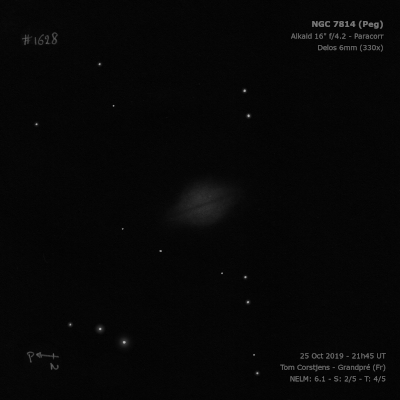
William Herschel discovered NGC 7814 = H II-240 = h2297 on 8 Oct 1784 (sweep 286) and logged "pF; pL; irr R; easily res." John Herschel made the single observation "B; L; irreg R; vgbM; 2' or 3' diam; no nucleus." R.J. Mitchell, LdR's assistant on 12 Oct 1885, wrote "pL and B, E, gmbM, a decided dark lane runs through it in the direction of the major axis. The neb is rather narrower in the middle of its length and spreads out laterally towards its extremities, fading away gradually. His sketch was included in the 1861 publication and in Plate 5, Fig 11 in the 1880 Lawrence Parsons publication. The sketch shows the thin dust lane bisecting the core and extending out through the arms.
200/250mm - 8" (11/8/80): moderately bright, slightly elongated.
300/350mm - 13.1" (10/10/86): bright, large, large bright core, elongated NW-SE, faint stellar nucleus.
400/500mm - 17.5" (8/2/86): very bright, very bright large core, fainter extensions NW-SE. Forms a pair with IC 5381 10' S. The narrow dust lane bisecting the galaxy was not seen. IC 5378 (Arp 130) lies 30' NNW.
17.5" (12/19/87): faint stellar nucleus visible.
900/1200mm - 48" (10/23/11): gorgeous view of this showpiece edge-on spiral at 375x and 488x. The oval central bulge was large and very bright, increasing to an intense core. A very thin, very high contrast dust lane sliced through the major axis of the galaxy, neatly bisecting the galaxy. On close inspection, the halo on the south side of the lane was marginally more extensive. At the center, a small nucleus is apparently obscured, leaving only two very small brilliant "knots" on either side of the lane. Beyond the central region, much fainter arms extend NW and SE, increasing the total size to 5'x1.5'. The dust lane was easily visible splitting the edge-on arms until they dimmed out at the tips.
Notes by Steve Gottlieb